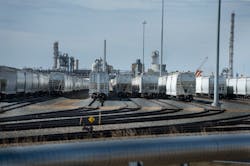Dow picks Alberta for proposed net-zero emissions ethylene complex
Dow Inc. plans to more than triple ethylene and polyethylene production capacity in a phased manner through 2030 at subsidiary Dow Chemical Canada ULC’s (Dow Canada) petrochemicals manufacturing site just north of Fort Saskatchewan, Alta., with a project that, if approved, includes construction of what will become the world’s first net-zero carbon emissions ethylene and derivatives complex.
Intended to support Dow’s internal sustainability targets as well as its external pledge to incrementally achieve carbon neutrality on a site-by-site basis across its global asset base by 2050 in line with the Paris Climate Accord, the proposed brownfield investment at Fort Saskatchewan comes as part of the operator’s strategy to continue investing in growth projects that position its businesses to competitively meet steadily rising demand for sustainably produced materials and low-carbon, renewable technologies for a net-zero future, Dow told investors on Oct. 6.
Still subject to approval by Dow’s board and regional regulatory agencies, the Fort Saskatchewan project—which, alongside new construction, includes revamps of the site’s existing units retrofitting them to zero-carbon dioxide (CO2) emissions as defined by Scope 1 and Scope 2 of the Greenhouse Gas (GHG) Protocol Corporate Accounting and Reporting Standard—would add about 1.8 million tonnes/year (tpy) fresh capacity in a phased manner through 2030 that will enable the site to produce and supply about 3.2 million tpy certified low to zero-carbon emissions polyethylene and ethylene derivatives total to global customers and joint venture partners, according to Dow.
Notable retrofits to Fort Saskatchewan’s current operations will entail upgrading existing infrastructure to accommodate installation of a new autothermal reformer that will convert cracker off gas into clean, circular hydrogen (H2) the complex can use to fuel its production processes, as well as enable introduction of a carbon capture and storage (CCS) component that would allow CO2 from the cracker to be captured on site and transported for storage by an adjacent third part, Dow said.
In addition to decarbonizing about 20% of Dow's global ethylene capacity and growing its supply of polyethylene by about 15% to result in $700 million-1.2 billion of EBITDA growth across the value chain by 2030, Dow said it expects to complete the project at about 15% lower capital intensity than it did the high-performing TX-9 ethylene cracker and derivative units at the operator’s olefins manufacturing complex in Freeport, Tex. (OGJ Online, Feb. 4, 2020).
Recently expanded by 500,000 tpy to a nameplate capacity of 2 million tpy and forming the basis of the proposed Fort Saskatchewan investment, the TX-9 currently runs consistently at more than 110% of its expanded capacity while emitting 60% less CO2/lb that other crackers in the Dow fleet without the advantages of H2 or CCS capabilities, the operator confirmed.
In addition to the region’s highly competitive energy and feedstock position and access to CCS infrastructure, Dow said it selected the Fort Saskatchewan site for the investment project because of Alberta’s favorable public policies and government support at both the local and provincial levels, which include market-based carbon price signals as well as incentives that derisk development.
"Alberta's support for circular hydrogen and CO2 infrastructure are essential to enabling us to develop this net-zero carbon emissions manufacturing facility," said Jim Fitterling, Dow’s chairman and chief executive officer.
"Canada's support for this type of investment can serve as a model for how government investment can encourage the development and accelerate adoption of emissions-avoiding technologies and solutions," Fitterling added.
Dow said similar government policies and support also have resulted in the operator’s decision to pursue the full clean-energy transition of its manufacturing site in Terneuzen, the Netherlands, where the operator is advancing use of feedstock made from recycled plastic waste to produce virgin polymers, as well as collaborating with Royal Dutch Shell PLC to design and scale development of electrified cracking technologies (e-cracking) powered by renewable electricity, which could result in eliminating the need of fossil-fuel combustion—and thereby emissions—to generate steam in cracker furnaces.
Dow, which has committed to reducing its net annual carbon emissions by 2020 by 30% from 2005 levels, said it now expects to allocate about $1 billion of annual capital expenditures on the phased decarbonization of its global assets on projects that continue to enable growth in a future carbon-neutral world.

Robert Brelsford | Downstream Editor
Robert Brelsford joined Oil & Gas Journal in October 2013 as downstream technology editor after 8 years as a crude oil price and news reporter on spot crude transactions at the US Gulf Coast, West Coast, Canadian, and Latin American markets. He holds a BA (2000) in English from Rice University and an MS (2003) in education and social policy from Northwestern University.

